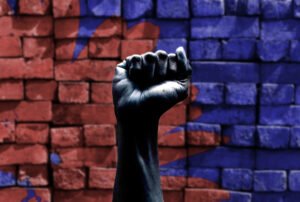
There’s a growing debate in Europe about how workers can take advantage of technological advances that increase productivity rates to redefine “the future of work.” Its proponents argue that companies have hoarded these advantages for too long; facing a future that is likely to require fewer workers (what with increased automation and artificial intelligence), now is a good time to balance the scales.
A series of warning strikes rippled across Germany last month, and by January 27th, “nearly a million workers from more than 4,500 companies had walked out…for a few hours at a time,” according to Inverse’s Eileen Guo. Then, on January 31st, Germany released its latest unemployment numbers: 5.4 percent, the lowest since reunification in 1990. That same day, a series of 24-hour strikes launched.
Guo writes, “Citing Germany’s strong economic growth, as well as increasing social responsibilities of workers outside of their jobs, IG Metall was asking for a six percent increase in wages and the right to temporarily reduce weekly hours from 35 to 28, with the right to return to full-time work after two years.”
The powerful IG Metall labor union represents 3.9 million German metal and electrical engineering workers. Sophie Jaenicke, of IG Metall’s Collective Bargaining Department, tells Inverse, “The real working time of employees is much longer than the collectively agreed working time. The employers have many possibilities to prolong working hours, but employees do not have possibilities to reduce their working time in the same way.”
So far, employers have offered a two-percent wage increase and a one-time payment of €200 ($239), but not a shorter work week. IG Metall chief Joerg Hofmann vows to increase the pressure.
This is not confined to Germany’s private sector. The public service workers union DBB will ask “for a ‘significant’ salary hike and a decrease in working hours from 41 to 39.” Meanwhile, its largest service sector union, Verdi, is calling for a six-percent salary increase and the option to trade salary for additional time off.
Sign up for our free newsletters
Subscribe to NPQ's newsletters to have our top stories delivered directly to your inbox.
By signing up, you agree to our privacy policy and terms of use, and to receive messages from NPQ and our partners.
As in the US, the German government “has indicated that providing better protections for workers…is on its agenda.” However, Rutgers University-based US economist Jennifer Hunt says, “The whole tenor of the debate in the US is completely different” due to comparably weaker unions. In the US, the focus is on more flexibility to advance work-life balance. Organizations like the Freelancers’ Union and 1 Million for Work Flexibility are fighting for their members to have more choice in determining things like working schedules and remote work.
Some see this as the purview of “well-to-do folks,” like the Silicon Valley workers whose employers offer “work arrangements that range from the standard 40-hour weeks condensed into longer but fewer days, office-wide working retreats, unlimited vacations, remote working opportunities, and even paid sabbaticals accrued just like time off.”
In the US, we’re selling workers’ demands for flexibility as not only beneficial personally to workers, but as profitable for companies. Emma Plumb, the director of 1 Million for Work Flexibility, says, “Our message is that for organizations and employees to be more productive and successful, it’s crucial to look beyond the traditional in-office, 9-to-5 workplace norm.”
However, experiments indicate that this is not the best frame for worker demands. Guo writes, “When Utah implemented its four-day work-week in 2008 for state employees, it abruptly ended the program three years later, saying that the move’s projected savings never materialized. A recent experiment in Sweden was also canceled because the cost outweighed the benefits.” For whom, one could ask?
Guo concludes, “The technological advances are speeding up, but the unified efforts of labor have disappeared for most American workers. Perhaps this explains, at least in part, why the work week has not changed for nearly 75 years.”
While the work of nonprofits seems to always be on the rise, perhaps it’s time for us to stop and think about the nature of work itself and how it overlaps with the societal values we seek. If we can’t create the world we want for ourselves, how can we create it for anyone else? What do you think? How can nonprofits help to redefine the future of work?—Cyndi Suarez













